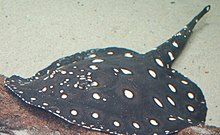

| Xingu River ray | |
|---|---|

| |

| |
| Scientific classification | |
| Domain: | Eukaryota |
| Kingdom: | Animalia |
| Phylum: | Chordata |
| Class: | Chondrichthyes |
| Subclass: | Elasmobranchii |
| Superorder: | Batoidea |
| Order: | Myliobatiformes |
| Family: | Potamotrygonidae |
| Genus: | Potamotrygon |
| Species: |
P. leopoldi
|
| Binomial name | |
| Potamotrygon leopoldi | |
The Xingu River ray, white-blotched river stingray, or polka-dot stingray (Potamotrygon leopoldi) is a species of freshwater fish in the family Potamotrygonidae. It is endemic to the Xingu River basin in Brazil and as such prefers clear waters with rocky bottoms.[1] It is sometimes kept in aquaria, like its more common relative the Motoro.[1]
The fish is named in honor of King Leopold III (1901–1983) of Belgium, who sponsored many scientific studies at the Institut Royal des Sciences Naturelles de Belgique.[3]
Potamotrygon leopoldi reaches up to 40 cm (16 in) in disc width,[4] 75 cm (30 in) in total length and 20 kg (44 lb) in weight.[5] Females grow larger than males.[6] It is closely related to the similar P. henlei from the Tocantins River basin and P. albimaculata from the Tapajós River basin.[7] Compared to P. henlei, P. leopoldi is deeper black above and its underparts are mostly brownish-dusky (large white center to underparts of P. henlei).[7][8] Compared to P. albimaculata, P. leopoldi has fewer and larger yellowish-white spots above.[7][8]
The Xingu river ray is a venomous stingray that contains venom localized at its dentine spine in its tail.[9] While the ray's venom composition does not change with maturation, the venom toxicity decreases as rays get older.[9] On the other hand, rays' jaw shape, stiffness, and mineralization are strengthened with age, which allows mature rays the ability to consume hard-shelled invertebrates.[10] These changes in traits with maturation reflect the different pressures rays experience in terms of functions such as feeding and avoiding predation during different maturity stages.[9]
{{cite journal}}: CS1 maint: multiple names: authors list (link)
| Potamotrygon leopoldi |
|
|---|---|
This batoid-related article is a stub. You can help Wikipedia by expanding it. |